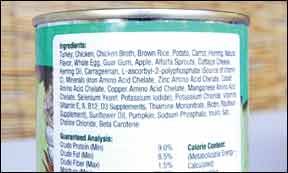Recently, a neighbor asked me for advice about her dog, who was vomiting and subdued. As part of our discussion about the dog’s upset stomach, I asked what kind of food she fed to the dog. She responded that she fed him high-quality wet food, “not the cheap stuff.” When I pressed her for the name of the brand, she said it was Beneful. Thankfully, her dog recovered quickly from whatever malady caused his vomiting, but our conversation haunted me for days. How does a person get the idea that Beneful is a high-quality food?

She’s not alone. There are apparently millions of people who buy Beneful and other pet foods made by Nestle Purina Petcare; the company is second on the list of highest grossing pet food manufacturers on the planet. Purina’s global retail sales in 2010 (the latest year for which complete figures are available) exceeded $14 billion. They must be doing something right, right?
In our opinion, what they are doing right isn’t optimum nutrition, however. The company may excel at marketing and manufacturing efficiency, but none of their well-known, popular wet foods are what we would consider healthful (we’ll explain why in a minute). But then, what global corporate behemoth makes truly healthy food? Companies with gargantuan production volumes can’t use ingredients of the highest quality in their foods; there isn’t a large enough global supply of ingredients of that quality!
Seriously, ingredient sourcing is a hot topic in the pet food industry right now. Increasingly educated and ever-more emotionally connected owners want to feed their pets foods with high-quality ingredients. Pet food makers that utilize top-quality ingredients have to compete with human food producers for those ingredients, and prices for all types of foods are rising dramatically. Drought in the U.S. has severely impacted corn production; high temperatures in Russia have affected its wheat crop. Both of these things affect the price of cattle, pork, and poultry feed, and thus the price of dairy products, beef, pork, eggs, and poultry. And yet, somehow, the price of the lowest-cost pet foods don’t seem to rise much, while the price of the highest-cost foods seems to spiral ever-higher. What’s up with that?
The answer is ingredient quality. While the price of a product shouldn’t ever be considered the sole indicator of a quality food, you have to keep in mind that products that contain high-quality ingredients will necessarily be priced a lot higher than bargain brands. If that can (or pouch or plastic tray) is inexpensive, what’s in it can’t possibly be “what’s best for dogs,” which is meat.
Mighty Meat
We strongly believe that there is nothing more nutritious and healthful for dogs than a well-formulated, home-prepared diet containing fresh, “human-quality” ingredients. If you’re not up for home-preparation, however, there are some compelling reasons to feed canned food to your dog as part or all of his diet.
The main reason is that good canned foods contain far more meat than any kibble can be manufactured with. Dogs have absolutely no nutritional requirement for carbohydrates – they can not just live, but can thrive on diets that contain only protein and fats. The fact that they are wondrously able to make use of just about any type of food we give them, grains included, doesn’t mean that grain-heavy diets are what’s best for them. Many holistic practitioners believe that the canine obesity epidemic and rising incidence of canine diabetes and allergies are due to the biologically inappropriate diets we feed to dogs. Animal proteins (meat, fish, and eggs) are what dogs have evolved to eat; we’re asking for trouble, many believe, by feeding them such an unnaturally carbohydrate-rich diet.
Other Benefits
It’s also unnatural for dogs to eat such a dry diet. Most kibble contains about 10 percent moisture. Meat and fish contain anywhere from 50 percent to 80 percent moisture. Feeding canned foods, which contain (on average) about 78 percent moisture, is therapeutic for dogs who have any sort of kidney ailment, and may be beneficial for all dogs.
Most dogs digest wet foods with far fewer digestive problems (such as excessive gas, diarrhea, or constipation) than dogs who eat dry kibble.
Wet food is far more palatable to most dogs than dry food. This is a huge benefit to any dog who needs to gain weight, whether due to illness, age, or high activity. (It can be a hazard, though, to dogs who are fat or prone to becoming overweight. Most canned foods are much higher in fat than most dry foods, so if your dog is fat or at risk of pancreatitis, look for canned foods with lower percentages of fat.)
Canned foods (the term describes all wet foods that are cooked inside a sealed container, whether it’s a can, pouch, or plastic tray) enable us to feed a diet that is biologically appropriate (with a high moisture content and a high inclusion of animal protein) and yet is shelf-stable – without the need for artificial or natural preservatives. (That stability lasts longer than even artificially preserved kibble, too.) When vitamin/mineral supplements are added to ensure the diets are “complete and balanced,” the overall benefits of canned food are compelling.
Selecting a Good Canned Dog Food
If you’re sold on the idea of canned food, great! Now it’s time to look for good ones. As always, the best way for a consumer to do this is to examine the label, skipping the pretty pictures of steaks and the marketing verbiage. Don’t allow yourself to work up an appetite by descriptions of spring vegetables, rosemary chicken, seared beef, grilled lamb, and other phrases; trust us, none of those things appear in the food in the form you envision when you read those words. The only thing you should pay attention to is the fine print of the ingredients list and the guaranteed analysis. You need to know what is actually in the food, and how much protein and fat will it deliver to your dog. Ingredients appear on the label in order of their presence in the formula by weight. And the protein and fat content appears in the “guaranteed analysis” portion of the label.
What should the food contain? What ingredients are less-than-desirable? See the chart below for a guide to the traits of top-quality and low-quality foods.
What about the products in the middle, the ones that contain some good and some undesirable traits? That gets trickier, but your budget – and most importantly, your dog’s response to the foods – may tip the balance for you one way or the other. Let’s look at some labels and do some comparing.
Traits of a Good Wet Dog Food
The highest possible inclusion of top-quality animal proteins. Look for a whole, named source of meat as the first ingredient (meaning the product contains more of that ingredient by weight than anything else). There are some good foods that list water or broth as the first ingredient and a meat ingredient second – but we’d choose a product with meat first on the label over one that listed meat second.
“Named” sources of any animal protein or fat, whether it’s a muscle tissue (in which case it will appear as chicken, beef, buffalo, etc.) or an organ meat (in which case it should specify which species it came from, for example, “beef liver”).
Whole grains or vegetables (if any are used in the formula).
Limited (if any) use of grain or vegetable by-products. For example, a food containing potato starch as the sixth ingredient would be preferable to one with the same ingredient in the third position on the ingredients panel. And a food that contained just one grain or vegetable by-product (such as oat bran) would be preferable to a product containing several (such as potato starch, oat fiber, and tomato paste).
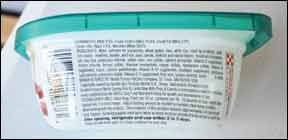
The words “complete and balanced.” Some manufacturers produce a few wet food products that are meant for “supplemental or intermittent” use only. These products do not meet the specifications for a “complete and balanced diet” as defined by the model regulations developed by the Association of American Feed Control Officials (AAFCO) and adopted by each state. While these “supplemental” foods may be useful as part of a varied diet, they can’t be relied on to provide all the nutrients your dog needs.
Traits of Low-Quality Wet Foods
Unnamed animal sources, such as meat, meat by-products, poultry, poultry by-products, or animal fat.
Meat by-products or poultry by-products. There is a wide range in the quality and type of by-products that are available to pet food producers. And there is no way for a dog owner (or anyone else) to find out whether the by-products used are kept clean, chilled, and used fresh within a day or two of slaughter (as some companies claim), or are comprised of ingredients that were literally swept off a floor, dumped down the floor drains at the processing plant, and kept for hours or days on unrefrigerated loading docks and trucks. Because you can’t know, avoid by-products.
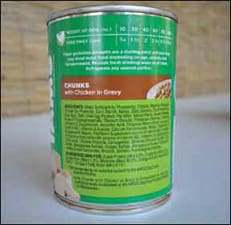
Wheat gluten. Wet foods often contain some sort of thickener or binder. Various types of “gum” (such as guar gum, from the seed of the guar plant, and carrageenan gum, from seaweed) are common thickeners. Whole grains, potatoes, and sweet potatoes also can be used to thicken wet food. But wheat gluten (and some other glutens) are generally used in wet foods both to augment the protein content of the food (albeit with lesser quality amino acids) and to act as a binder, to hold together artificially formed “chunks” so that they resemble chunks of meat. In other words, it’s a signal that the real meat content of the product is less than ideal. If chunks of meat are present in a wet dog food, they should be actual chunks of meat.
Sugar or other sweeteners. A food that contains quality meats shouldn’t need additional palatants to entice dogs.
Artificial colors, flavors, or added preservatives. Fortunately, these are rare in wet foods!
This one is easy:
This is Beneful’s “Savory Rice & Lamb Stew,” and it’s chock full of the “traits to avoid.” We won’t hold the fact that water is the first ingredient against the product; there are good foods with water as the first ingredient, too. But wheat gluten is the second ingredient. WOW. Think about that: By weight, there is more wheat gluten in this food than meat – which is crazy, because meat is full of moisture, which is heavy!
There are more “traits to avoid,” too: meat by-products (could be anything); “liver” (no species named); artificial and natural flavors (if the food contained a lot of meat, the maker wouldn’t need to add flavors to make it palatable); and added color (to make it pretty for you!).
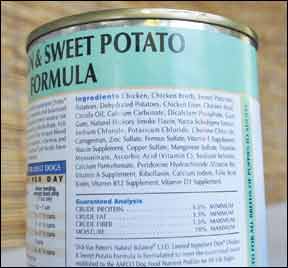
Any “desirable traits”? Lamb and chicken are in there, but since they appear 6th and 8th on the label, their contributions are actually not very significant. Same goes for wild rice, peas, and carrots; appearing in the 9th, 10th, and 11th spots on the label, they aren’t contributing much.
Here is one of those mixed bags of good and undesirable traits:
This is Iams’ “Proactive Health Chunks with chicken in Gravy” and the ingredients start out nicely: Water (okay), chicken (great!), and then meat by-products and chicken by-products (sigh). Check out the addition of broccoli and spinach, way down under all the vitamins and minerals. Why bother, at that level of inclusion? (We can’t even imagine what such a tiny amount of broccoli and spinach would look like in a cooking vat full of this food!)
This next one is one of our “approved canned foods”:
It is Natural Balance’s “Limited Ingredient Diets Chicken & Sweet Potato Formula.” It has a lot going for it, including the fact that chicken appears first on the ingredients list, and the moisture (2nd) that’s been added for processing purposes is chicken broth: nice! Look what’s next, however: sweet potatoes, potatoes, and dehydrated potatoes. By the time you add up all that potato, does it outweigh the animal protein (even with chicken liver and chicken meal in 6th and 7th positions)?
One more thing. Look a little lower on the label, at the guaranteed analysis: The fat content is just 3.5 percent. That may make it highly appropriate for dogs who need a lower-fat food. And this is why you need to be aware of how much fat and protein you currently feed your dog, whether or not he needs to gain, hold, or lose weight, and given those factors, what effect this product may have if added to his diet.
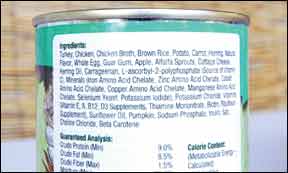
Here is another one of our “approved canned foods”:
This is Natura Pet Product’s Innova. We love that there are two whole, named meats first on the ingredients list, and that the moisture that has been added (3rd) is chicken broth. There are more carbohydrates in here than there needs to be (brown rice, potato, carrot), but they are all whole and not repetitious (like when you see brown rice and white rice in the same formula), so as long as they work for the dog we are feeding, we’re fine with that.
However, look sharp: Check out that fat content, a whopping 8.5 percent! That might be super for your working Border Collie or field hunter, or a major problem for your Poodle with pancreatitis. Always read the label!
In the “Whole Dog Journal’s 2012 Canned Dog Food Review” you will find a list of companies that make foods that meet all of our selection criteria for healthy, high-quality canned foods. Again, they all make great foods, but not all of the foods they make are appropriate for every dog, so check the ingredients panel and guaranteed analysis for every variety you consider feeding to your dog. The list is ordered alphabetically by the manufacturer, so if you don’t see the name of your favorite food, look at the label of the food to see what company makes it! As you try different products, keep track of your dog’s weight, and adjust the type and amount of food you feed accordingly.


